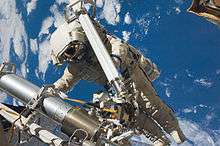Anton Shkaplerov
| Anton Nikolaevich Shkaplerov | |
|---|---|
 | |
| Cosmonaut | |
| Nationality | Russian |
| Born |
February 20, 1972 Sevastopol, Crimea |
Other occupation | Colonel, Russian Air Force |
Time in space | 365d 00h 13m |
| Selection | 2003 Intercosmos Group |
| Missions | Soyuz TMA-22 (Expedition 29/30), Soyuz TMA-15M (Expedition 42/43) |
Mission insignia |
|
Anton Nikolaevich Shkaplerov, (Russian: Антон Николаевич Шкаплеров) (born February 20, 1972 in Sevastopol, Ukrainian SSR) is a Russian cosmonaut.
Personal
Shkaplerov is married to a Tatyana Petrovna, and they have two daughters named Kristina and Kira. His parents, Nikolay Ivanovich Shkaplerov and Tamara Viktorovna Shkaplerova, live in Sevastopol. His hobbies include sports, travel, fishing, and golf.[1]
Education
Shkaplerov completed Yak-52 flight training at the Sevastopol Aviation Club in 1989. After graduation from Sevastopol High School in 1989, he entered the Kachinsk Air Force Pilot School graduating in 1994 as pilot-engineer. In 1997 he graduated from the N. E. Zukovskiy Air Force Engineering.
Experience
After graduation Shkaplerov served as a senior pilot-instructor in the Russian Air Force. He has piloted Yak-52, L-29 and MiG-29 aircraft. He is a Class 2 Air Force pilot-instructor. He is also an Instructor of General Parachute Training, and has performed more than 300 parachute jumps.
Roscosmos career

In May 2003 Shkaplerov was selected as a test-cosmonaut candidate of the Gagarin Cosmonaut Training Center Cosmonaut Office. From June 2003 to June 2005 he attended basic space training and was qualified as a test cosmonaut in 2005.
From April–October 2007, Shkaplerov served as Director of Operations, Russian Space Agency, stationed at the Johnson Space Center in Houston, Texas.
Anton was assigned as the back-up commander for Expedition 22.
Expedition 29/30
Shkaplerov served as a Flight Engineer for Expedition 29/30 aboard the ISS.
Expedition 42
On November 23, 2014, Soyuz TMA-15M carrying Shkaplerov and two other astronauts launched from the Baikonur Cosmodrome, Kazakhstan. It successfully docked at the International Space Station roughly six hours later.[2]
Spacewalks
On February 12, 2012, Shkaplerov and fellow cosmonaut Oleg Kononenko were scheduled to conduct a six-hour spacewalk outside the ISS. They were to install shields on the Zvezda Service Module to protect it from micrometeoroid orbital debris and move the Strela 1 crane from the Pirs docking compartment to the Poisk Mini Research Module (MRM-2). If time permits, the two cosmonauts were also to install struts on a ladder used by spacewalkers on the Pirs Docking Compartment. As another get-ahead task, they would possibly install an experiment called Vynoslivost on the Poisk Mini Research Module. As part of the Vynoslivost or "Endurance" experiment, two trays of metal samples would be left exposed on the surface of the Poisk Module.[3]
References
![]() This article incorporates public domain material from websites or documents of the National Aeronautics and Space Administration.
This article incorporates public domain material from websites or documents of the National Aeronautics and Space Administration.
- ↑ NASA (July 2011). "Cosmonaut Bio: Anton Shkaplerov". Retrieved August 8, 2016.
- ↑ Associated Press. "Crew docks at International Space Station". USA Today. Retrieved 24 November 2014.
- ↑ "Soyuz TMA-03M". Russianspaceweb.com. December 23, 2011. Retrieved December 25, 2011.